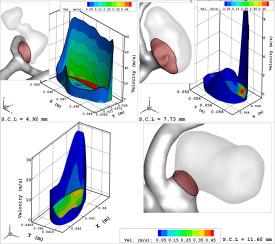Computational evaluating on the role of sac centerline length on hemorrhage risk of anterior cerebral artery with saccular aneurysm
IF 4.6
2区 物理与天体物理
Q1 PHYSICS, MULTIDISCIPLINARY
引用次数: 0
Abstract
The present article investigates geometrical features of an aneurysm, particularly the sac centerline length (SCL), in determining the hemodynamic environment within the aneurysm for evaluation of the hemorrhage risk. Indeed, understanding how these geometric characteristics influence blood flow patterns is essential for assessing rupture risk and optimizing treatment strategies. Computational fluid dynamic is used to perform computational modeling of the blood hemodynamic in Anterior Communicating Artery (ACA) cases. Wall shear stress (WSS), Oscillatory Shear Index (OSI) and pressure over sac surface are investigated and compared for selected saccular aneurysm to evaluate risk of aneurysm rupture when sac centerline length is varied. Comparison of the results show that the inverse relationship between sac centerline length and these key hemodynamic parameters (OSI, velocity, WSS) underscores the importance of geometrical factors in assessing aneurysm rupture risk. Longer sac centerline lengths appear to be associated with more stable flow dynamics and reduced mechanical stress, while shorter sac lengths correlate with more disturbed and high-stress conditions.

计算评估囊中心线长度对大脑前动脉囊状动脉瘤出血风险的影响
本文研究了动脉瘤的几何特征,尤其是囊中心线长度(SCL),以确定动脉瘤内的血流动力学环境,从而评估出血风险。事实上,了解这些几何特征如何影响血流模式对于评估破裂风险和优化治疗策略至关重要。计算流体动力学用于对前沟通动脉(ACA)病例的血液动力学进行计算建模。研究并比较了选定囊状动脉瘤的壁剪应力(WSS)、振荡剪切指数(OSI)和囊表面压力,以评估囊中心线长度变化时动脉瘤破裂的风险。比较结果表明,囊中心线长度与这些关键血液动力学参数(OSI、速度、WSS)之间的反比关系强调了几何因素在评估动脉瘤破裂风险中的重要性。较长的囊中心线长度似乎与较稳定的血流动力学和较低的机械应力有关,而较短的囊长度则与较紊乱和高应力条件有关。
本文章由计算机程序翻译,如有差异,请以英文原文为准。
求助全文
约1分钟内获得全文
求助全文
来源期刊

Chinese Journal of Physics
物理-物理:综合
CiteScore
8.50
自引率
10.00%
发文量
361
审稿时长
44 days
期刊介绍:
The Chinese Journal of Physics publishes important advances in various branches in physics, including statistical and biophysical physics, condensed matter physics, atomic/molecular physics, optics, particle physics and nuclear physics.
The editors welcome manuscripts on:
-General Physics: Statistical and Quantum Mechanics, etc.-
Gravitation and Astrophysics-
Elementary Particles and Fields-
Nuclear Physics-
Atomic, Molecular, and Optical Physics-
Quantum Information and Quantum Computation-
Fluid Dynamics, Nonlinear Dynamics, Chaos, and Complex Networks-
Plasma and Beam Physics-
Condensed Matter: Structure, etc.-
Condensed Matter: Electronic Properties, etc.-
Polymer, Soft Matter, Biological, and Interdisciplinary Physics.
CJP publishes regular research papers, feature articles and review papers.
 求助内容:
求助内容: 应助结果提醒方式:
应助结果提醒方式:


